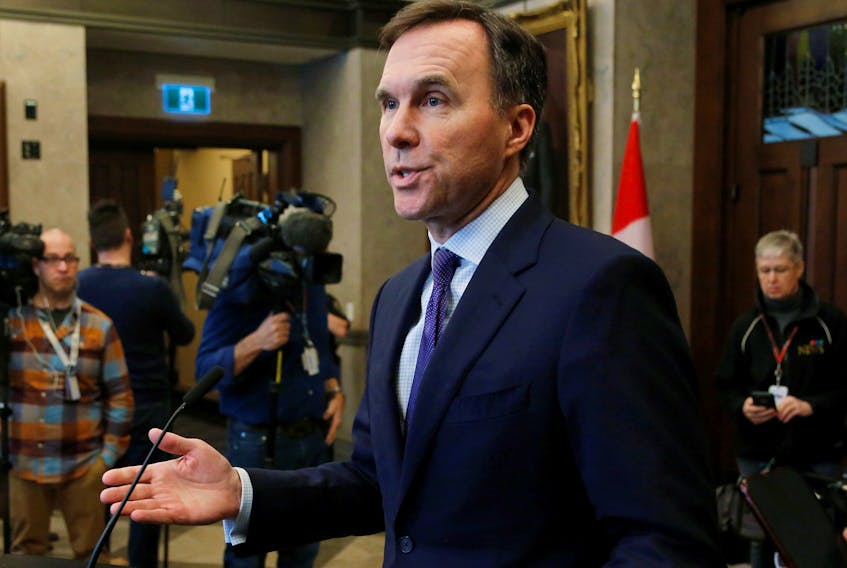OTTAWA — Get ready to rehire employees: that was the message from Finance Minister Bill Morneau on Wednesday as he revealed new details about the Canadian Emergency Wage Subsidy (CEWS).
The CEWS, first announced last week, will provide a wage subsidy of 75 per cent to businesses that face an interruption in revenue due to shutdowns and closures caused by the COVID-19 pandemic.
On Wednesday, Morneau announced the subsidy will be available to Canadian businesses “big and small, individuals, partnerships, and corporations” that are not publicly funded and that have seen a 30 per cent or more decline in gross revenue since this time last year.
The wage subsidy of 75 per cent will be provided for the first $58,700 of normal salary up to a maximum of $847 a week per employee.
Morneau noted the subsidy will include the hospitality sector, which has been particularly hard hit by the pandemic, as well as non-profit groups and charities that see a similar decline in revenue.
Employers will be able to apply online through a Canada Revenue Agency portal that will launch soon, and Morneau said funds will be available in approximately six weeks.
The revenue decline of 30 per cent or more required to apply will be determined by comparing revenues to the same month last year for March, April or May, and businesses will need to reapply each month.
“As an employer, you'll need to attest that you're doing everything you can to pay the remaining 25 per cent of your workers’ income,” Morneau said.
“We know this will not always be possible, but the system will be flexible, because what is most important is that Canadians can come back to work.”
Morneau also said there will be consequences for any businesses that are caught abusing the system.
“In this time of crisis, anyone who attempts to use this money for fraudulent purposes will face severe penalties,” he said. “This is a high-trust system we are putting in place and we will take decisive action against anyone who breaks that trust.”
It is estimated the CEWS will cost $71 billion and reduce the cost of the previously announced Canadian Emergency Response Benefit (CERB) to $24 billion. The CERB will provide $2,000 per month for up to three months for Canadian workers who have lost their source of income due to the COVID-19 pandemic.
“Making sure Canadians feel secure in their jobs is a boost to confidence we all need in this challenging time. It is a sense of hope that life will get better even as we deal with stress and sickness,” Morneau said.
“The Canadian government will make sure families have a decent income and that businesses stay strong and ready to get back to work when we rise from this crisis.”
Details announced
The federal government also provided more details Wednesday on the CERB, including the confirmed launch date for the application process of April 6.
The website where Canadians can apply has been launched at canada.ca/coronavirus-cerb and now has more information on eligibility criteria.
Employment Minister Carla Qualtrough said Wednesday the benefit will be jointly administered by Service Canada and the Canada Revenue Agency.

“This will leverage the Government of Canada's two largest payment systems aligned for more timely and accurate delivery of this important emergency benefit,” she said,
When applying, Canadians can choose direct deposit, which will arrive between three and five days after they apply, or by cheque, which will take approximately 10 days.
Qualtrough said those who will be eligible should open an account with Service Canada or with the Canada Revenue Agency before Monday.
To reduce the strain on the system, the government is asking Canadians to apply to the CERB based on their birthdates: those born in January, February and March are to apply on April 6, those born in April, May and June are to apply on April 7, those born in July, August or September are to apply on April 8 and those born in October, November or December are to apply on April 9. The government says this system will not affect when people get their payments.
For Canadians who have already applied for EI, there is no need to re-apply — all these applications will be automatically enrolled in the CERB, Qualtrough said, adding that anyone who applied for EI after March 15 will receive the CERB payment, not EI.
Qualtrough said there have been 1.3 million EI requests filed in the last two weeks, and, for comparison, in 2019 there were 2.1 million requests filed in the entire year.
She said the government is doing what it can to get through them, including pulling people out of retirement, and has so far processed more than 330,000 claims.
“In the space of a few weeks Service Canada has developed a streamlined process that starting today will be able to automatically process approximately 400,000 applications per day,” she said.
“That means the backlog of COVID-19-related applications will be addressed in the next week and could also mean that some Canadians who have already applied through EI will begin receiving their CERB payment over the course of the next few days.”
Also on Wednesday, Health Minister Patty Hajdu announced Health Canada has launched an app where Canadians can get up-to-date information on the COVID-19 pandemic in Canada, including advice for preventing the spread of the coronavirus, important contact information, guidance for seeking medical help and a symptom-checker.
The app is called Canada COVID-19 and is available from the Apple and Google app stores.
In addition, Hajdu said the government will launch an online mental-health toolkit to help Canadians who are struggling with anxiety, depression or other mental-health issues.









